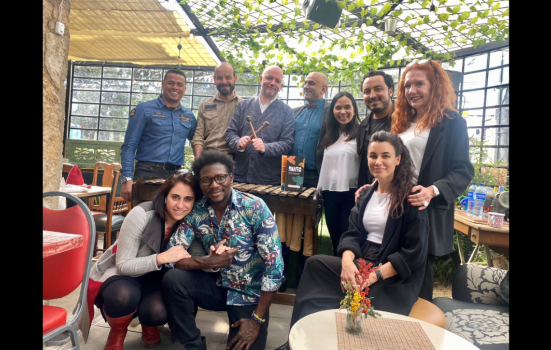In his work with the British Council, Skinder Hundal is privileged to meet cultural professionals and creatives from across the globe. Black History Month is an opportunity for him to reflect on the cultural expression of African and indigenous communities.

British Council
Most recently, I travelled to Colombia and then Mexico to attend the UNESCO MONDIACULT conference. While visiting the creative neighbourhood of San Felipe in Colombia, my colleagues and I met Absalon at the Afro-Colombian music festival Petronio Alvaraz. The biblical name Absalon means ‘father of peace’ in Hebrew; he performed with much joy.
His performance was symbolic of many things. As a group, we were connecting with the sounds and essence of African culture. As an artist, he shared a code of identity and ritual, a signature expression fusing the Colombian Spanish language with an African melody, rhythm and soul. It was an example of the language of art transcending barriers and connecting people.
Absalon is a musician who performs the marimba, an African percussion instrument. He is of Black African descent but does not know for sure where his ancestors came from, only that they were snatched from Africa and forced into slavery, ending up in Colombia.
Absalon was born on the Pacific coastline near Cali and now lives in Bogota in Colombia. He believes his family roots may be from Congo based on the rhythms played out on the marimba. The song he shared was from the perspective of an African child: ‘Mother, father where are you now, I can’t find you’. It was performed with much emotion and was representative of the cruelty of slavery.
Culture as a global public good
In Mexico, at the UNESCO-MONDIACULT Conference, Ministers of Culture from across the globe signed a declaration for cultural rights for all that explicitly acknowledged culture as a global public good, with an intrinsic value to enable and drive sustainable development.
Throughout their deliberations, there was a strong call for greater diversity, inclusion and the expression of African and indigenous communities in the global arts and cultural sector. This call is particularly significant as arts and culture provide a powerful space, offering a language, activity and expression from all cultures, providing key narratives, and bringing communities together.
From a personal perspective, I can vouch that when I encountered and embraced the family of arts, it was life-changing. As a person of colour growing up in a Western white context, the cultural offer was often limiting. Much of my cultural experiences was through my parental heritage, mainly Indian cinema, Punjabi and Hindi film music, food and weekend parties. Those small family gatherings gave me a great sense of peace, belonging and solidarity.
When I discovered an arts centre and movement dedicated to people of colour, especially from my generation, there was a powerful moment of solidarity and a renewed sense of belonging. It was the creativity and expression of artists that was so enticing. Not only did it bring people of colour together but also provided a space for cultural exchange, building friendship, trust and a better understanding of one another.
Art is the language of emotion
When we feel the meaning of our words and narratives, we share our vulnerabilities. When we break the ice of emotional blocks with one another, be that joy or deeper empathy, we become more humane, we connect. Sounds obvious, but in a world of many pressures, we can sometimes forget these basic realities we all need. The darkness of racism and the trauma of the vast past, especially for people of African origin and indigenous cultures, means that art is a great healer but also a space to define and share an identity.
This was also evident during the pandemic as not only did we default to our screens but also to art and culture. In the UK, communities of colour were adversely affected by the pandemic, highlighting pre-existing social and structural inequalities. I lost both my mother and sister. It was nature, art and culture, and friendships that helped my healing and continue to do so this very day.
In the UK, we have an impressive choice and realisation of the importance of inclusive and diverse expression from people of African and Caribbean descent. The emergence of festivals such as the launch of the Black Lives Matter Festival #WeMove, produced by changemakers like Kayza Rose, offers a new generational approach to identity and creative expression, inclusive of queer communities.
October should not be the only month
Additionally, such new initiatives build on the zeitgeist of the Black Lives Matter movement and provide Black communities in particular a space to explore intracultural dynamics of complex subjects and evolving identities. The extensive programme, curated by seasoned producers like Pawlet Brookes of Serendipity Institute for Black Arts and Heritage, also continues to offer audiences an extensive variety almost every day throughout Black History Month.
These platforms, among others, offer artists and communities a great moment to rethink and value themselves. For communities of colour to be given the autonomy to produce their inherited and contemporary expression offers a sense of belonging and self-worth, bypassing yet challenging structural inequalities in the long term.
Black History Month is a positive moment to reflect, celebrate and harness talents and key narratives that bring us all together. This month-long observance must also be a springboard in offering a drive for the year ahead. October should not be the only month where artists of African and Caribbean descent are recognised because every day we need to belong, be together and connect intra- and inter-culturally.
There is no better way but to connect cultures through arts. Key institutions and ministerial policies at the local and global levels need to create a fertile ground for inclusivity as communities can easily lose faith, disenfranchise and live in silos of separation. That is not a world I would want to live in, would you?
Skinder Hundal MBE is Global Arts Director at the British Council.
![]() @SkinsBC | @BritishArts
@SkinsBC | @BritishArts





Comments
Change Agent replied on Permalink
Black History Month (BHM)